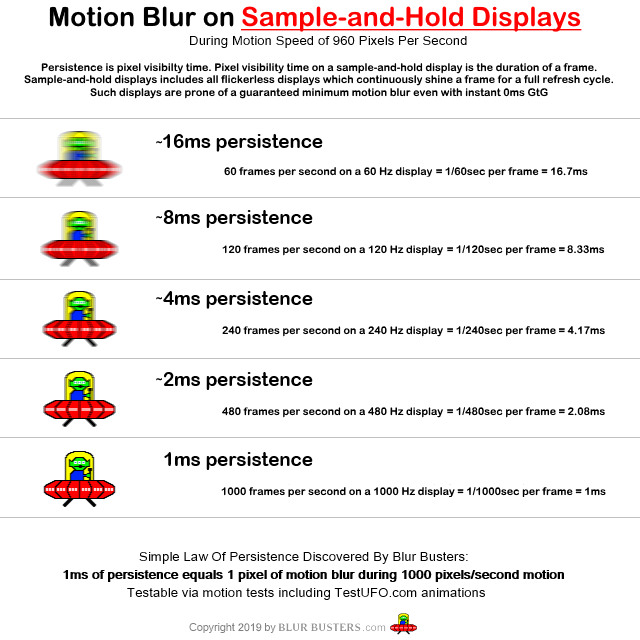For future silicon, this isn't as big/insurmountable problem because there are frame rate amplification versions of ray tracing arriving. In about ten years, RTX ON graphics with 1000fps should be likely possible through a tiered rendering pipeline where only 1 in 5 frames, or 1 in 10 frames are full complete GPU rerenders, with the rest of frames utilizing shortcuts of various frame rate amplification technologies (see below).
But for working with existing silicon, RTX+blur reduction is a very hard problem (raytracing producing frame rates too low to be easily motion blur reduced). MSAA is only a temporary humankind step, anyway.
Also, while strobing is good, it is Blur Buster's goal to make strobing obsolete someday anyway (long term goal) -- sheer refreshrate+framerate as the motion blur reduction method -- 1000fps 1000Hz nonstrobed is superior to 100fps strobed in so many ways. Some information about the strobeless method of motion blur reduction is explained in
Pixel Response FAQ: GtG Versus MPRT.

Motion blur reduction via sheer framerate is HARD: Doubling frame rate halves display motion blur (MPRT). Those with 240Hz monitors watching
www.testufo.com or
www.testufo.com/vrr has already noticed this pattern already. That's why you need to upgrade refresh rates and frame rates geometrically (60 -> 120 -> 240 -> 480 -> 960) to punch the diminishing curve of returns. Even things like 1000Hz mice is becoming a limiting factor -- one now needs a 2000Hz mouse poll rate for a 360Hz monitor, since the 1000Hz mouse is now a significant cause of diminished difference between 240Hz versus 360Hz.
Now, how do we do this while also keeping ray tracing? RTX ON eats up so much frame rate, even with DLSS 2.0, that it is frequently difficult to get framerates high enough to be strobed.
____
BTW I have a
Twitter reply thread, unrolled here:
____________
The temporal domain can be added to raytracing as a long-term fix. NVIDIA cited me in a Temporally Dense Raytracing paper:
https://research.nvidia.com/publication ... -Dense-Ray
I am on Page 2 of the PDF (
last link).
I believe ray tracing will be combined with various forms of frame rate amplification technologies, to have motion-compensated ray tracing & motion-compensated denoising, as a Frame Rate Amplification Technology:
Frame Rate Amplification Tech (FRAT) — More Frame Rate With Better Graphics
Also, reprojecting the rays helps to an extent, too. Raytracing motion (e.g. moving light sources) liklely don't need to run at framerates as high as strafe/turn/etc, for future upcoming 1000fps-1000Hz displays coming 2030 (prototypes are in the lab).
Blur Busters Law: The Amazing Journey To Future 1000Hz Displays
Once 1000fps-1000Hz workflows arrive (sooner in life than many think) -- it resembles tiered pipelines similiar to how Netflix is only 1fps with ~23 intelligently "filled-in" frames. We are already at 2:1 ratios with Oculus (45->90) but tomorrow will be 10:1 (100fps->1000fps)

This does not create lag like interpolation because of 1000Hz controller input, which will autofeedback into the frame rate amplification tech pipeline, to virtually flawlessly produce new 3D rendered frames without a full GPU rerender, via various tricks.
Admittedly, it doesn't help today's hardware, as upcoming 1000fps-1000Hz "RTX ON" workflows require new silicon dedicated to frame rate amplification techniques. Work being done there. Problem of high frame rates vs having rays, still remains today, DLSS 2.0 is but one mere step.

